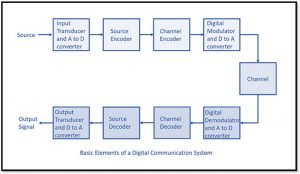1. Sampling theorem is mostly used in
- Amplitude modulation (AM)
- Frequency modulation (FM)
- PCM
- none of these
Answer – (3)
2. What is effective to decrease cumulative error?
- PCM
- DPCM
- Delta Sigma Modulation
- ADM
Answer – (2)
3. What is the Nyquist rate for x(t) = 8cos200πt to remove aliasing effect?
- 50Hz
- 100Hz
- 200Hz
- 400Hz
Answer – (3)
4. How many bits are in need to characterize a 256-level quantization in Pulse Code Modulation ?
- 7
- 5
- 6
- 8
Answer – (4)
5. In Pulse Code Modulation, the amplitude level is transmitted in a 7-units channel code. The sampling is thru at the rate of 10 KHz. The least BW
- 5 KHz
- 36 KHz
- 70 KHz
- 85 KHz
Answer – (2)
6. In Pulse Code Modulation use Lpf
- remove aliasing effect
- remove quantization noise
- remove decoding noise
- none of these
Answer – (1)
7. Adaptive Delta Modulation >> delta modulation as
- provides better noise performance
- it utilize less number bits used for encoding in communication
- it doesn’t suffer from slope overload and threshold effects
- simple circuit architecture
Answer – (3)

8. The compander in a telecom system is utilized for
- equalizing the SNR for both weak and strong PAM signals
- increasing amplification of the signals
- improving A/D conversion
- improving multiplexing
Answer – (3)
9. Using non-uniform quantization leads to
- decrease of transmission band-width
- increase in maximum Signal to Noise Ratio
- increase in Signal to Noise Ratio for low band signals
- Generalization of quantization method
Answer – (3)
10. What should be the Nyquist sampling rate for the signal s(t) = 10cos (50πt)cos2(150πt) when t is in seconds?
- 150 samples/second
- 200 samples/second
- 300 samples/second
- 350 samples/second
Answer – (4)
11. In a Pulse Code Modulation system, the number of bits (per sample) is increased from n to n+1, the enhancement in Signal to Noise Ratio will be
- 3 dB
- 6 dB
- 2n dB
- n dB
Answer – (2)
12. We detect a PAM signal by using
- an ADC
- an integrator
- a bandpass filter
- a high pass filter
Answer – (2)
13. What is the no of bits capable to characterize a 256-level quantization in Pulse Code Modulation?
- 7
- 8
- 5
- 6
Answer – (2)
14. The key advantage of Pulse Code Modulation are
- possibility of TDM
- less channel bandwidth
- less transmission powers
- better noise performance
Answer – (4)
15. Regenerative repeater could be utilized in
- Analog communication
- Digital communication
- Both
- None of these
Answer – (2)
16. In digital communication, Companding is used to
- Reduce the probability of errors
- Reduce quantization noise
- To increase signal strength
- Improve signal to noise ratio for low level input signals
Answer – (4)
17. The granular noise ensues in the Delta Modulation when the modulating signal
- When the modulating signal increases rapidly
- When the modulating signal changes with the step size
- When the modulating signal decreases rapidly
- When the modulating signal has high frequency component
Answer – (2)
18. In which modulation technique, redundant bits should be reduced
- ADM
- DPCM
- PCM
- none of these
Answer – (2)
19. In a Pulse Code Modulation, the no of quantization level is equal to sixteen and 4 kHz is maximum signal frequency. What is the bit transmission rate?
- 64 kbps
- 32 kbps
- 16 kbps
- 8 kbps
Answer – (3)
20. Flat top sampling refers to
- an aperture effects
- aliasing
- loss of the signal
- none of these
Answer – (1)
21. In the present day standard digital voice communication, the amplitude of the voice signal is sampled at a rate of around
- 2000 samples/sec
- 800 samples/sec
- 16000 samples/sec
- 8000 samples/sec
Answer – (4)
22. Choose the right option which is digital in nature
- PAM
- PPM
- DM
- none of these
Answer – (4)
23. Pulse suffering is used in
- Synchronous TDM
- Asynchronous TDM
- Any TDM
- none of these
Answer – (2)
24. The key benefit of Time Division Multiplexing over Frequency Division Multiplexing is that it
- needs less power
- needs less bandwidth
- needs simple circuitry
- gives better S/N ratio
Answer – (3)
25. The SNR in PCM system is reliable on
- sampling rate
- number of quantization levels
- message signal bandwidth
- none of these
Answer – (2)
26. A random variable is computed by no. of independent events having Gaussian probability distribution. It is
- central limit theorem
- superposition
- convolution
- correlation
Answer – (1)
27. The probability density function of the envelope of narrowband Gaussian noise is
- Poisson
- Gaussian
- Rayleigh
- Rician
Answer – (3)
28. Random process termed “ Ergodic” when
- All Ensemble average is not variable
- All Ensemble average is constant
- All Ensemble average is substitutable
Answer – (2)
29. A box having four white and three black color balls. Three balls are drawn from the box in succession. Compute the probability that the first two balls are white and the third one is black
- 6/35
- 4/35
- 3/35
- 7/35
Answer – (1)
30. The power spectral density of white noise
- Keeps changing as square root of frequency
- Keeps changing as inverse of frequency
- changes as square of frequency
- stays constant with frequency
Answer – (4)
31. Two dice are thrown simultaneously. The probability of receiving number “5” is?
- ⅓
- 1/9
- 1/12
- 1/36
Answer – (4)
32. The spectral density plot of white noise will be
- Exponential
- Uniform
- Poisson
- Gaussian
Answer – (2)
33. A rectangular pulse of duration T is used in a matched filter circuit. The output of filter is a
- Rectangular pulse of duration T
- Rectangular pulse of duration 2T
- triangular pulse
- impulse function
Answer – (3)

To learn more on Encoding and other electronic topics click here

Hi, I am Soumali Bhattacharya. I have done Master’s in Electronics.
I am currently invested in the field of Electronics and communication.
My articles are focused on the major areas of core electronics in a very simple yet informative approach.
I am a vivid learner and try to keep myself updated with all the latest technologies in the field of Electronics domains.
Let’s connect through LinkedIn –